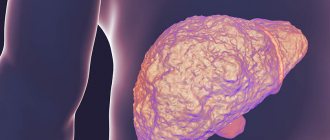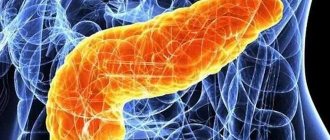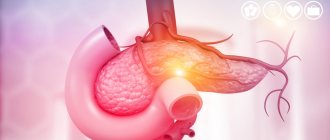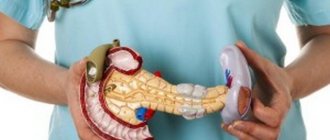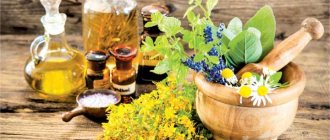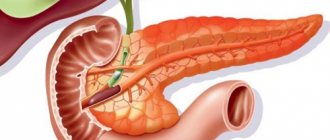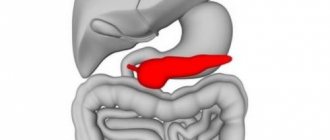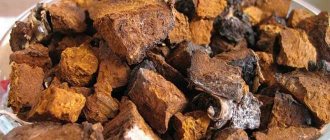The pathology develops slowly, and at the initial stages there are no clinical manifestations. This complicates diagnosis in the early stages and in this sense represents a danger: if changes are not detected, the process will progress and the organ will die. If most of the tissue is represented by fat cells, its shape will be preserved, but its function will not be restored.
Pancreatic steatosis: what is it?
To answer this question, we need to delve into the anatomy of the digestive system. It is represented by several organs, among which the pancreas deserves special attention. It has many functions:
- Participation in the digestion process (production of enzymes necessary for this process).
- Regulation of the endocrine system (carbohydrate metabolism, insulin production).
- Reaction to pathological changes in the body.
The functioning of the main systems of internal organs depends on the work of the pancreas. Its involvement in the pathological process necessarily affects the health of the whole organism.
Very often, people who prefer junk food develop pancreatic steatosis. This is a serious disease in which organ cells are replaced by fatty elements. Its main danger is that at first there are no obvious symptoms of the pathological process. The patient may not be aware of health problems for many years.
What is the mechanism of development of this disease? Under the influence of certain factors, gland cells begin to die. The immune system reacts to this process. It begins to actively produce fatty elements, which occupy the vacant spaces in the organ. Thanks to this replacement, the shape of the gland is preserved, but its primary functions are lost.
The essence of the problem
The concept of “steatosis” in medicine is understood as a protective reaction of the body in response to aggressive environmental factors. The death of pancreatic cells causes active growth of adipose tissue in their place. This leads to a decrease in the number of functioning pancreatocytes and progressive organ failure. Since the causes of damage to the gastrointestinal tract are the same, steatosis of the liver and pancreas is often diagnosed together.
Despite the imperfection of this protective mechanism, steatosis allows the body to recover, although not completely, even after serious pathological processes.
Five main causes of steatosis
The development of the disease can be triggered by:
- Poor nutrition (eating salty, fatty or fried foods).
- Adverse habits (smoking, drinking alcohol).
- Acute or chronic form of cholecystitis.
- Various pathological ailments of the gastrointestinal tract.
- Cholelithiasis.
Pancreatic steatosis is sometimes hereditary. If close relatives have been diagnosed with the disease, the likelihood of its occurrence increases several times. Mature people are most susceptible to pathological processes in the pancreas. The risk group includes men and women over 60 years of age, as well as alcohol abusers.
Causes of the disease
In rare cases, steatosis is formed under the influence of hereditary factors. In most cases, the pathological process is formed under the influence of the patient’s usual lifestyle, individual bad habits and preferences. Doctors identify several variations of the prerequisites for the formation of the problem.
In case of toxic effects on the diseased organ:
- Excessive passion for alcoholic beverages - small amounts of alcohol can disrupt the functioning of organs. Constant abuse provokes the formation of severe pathological abnormalities.
- Drug poisoning is uncontrolled use; an incorrectly selected treatment regimen can lead to problems. The disease is formed under the influence of antibacterial, corticosteroid, cytostatic medications.
- Nicotine addiction – constant use of tobacco products negatively affects the health of these organs.
For metabolic abnormalities:
- With excess body weight and obesity of various degrees - a violation of the requirements for a balanced diet, with large volumes of fried, fatty, carbohydrates, which the gastrointestinal tract system is not able to process. Pathological entrainment leads to the occurrence of steatosis.
- In type 2 diabetes mellitus , insufficient production of insulin, which is responsible for reducing glucose levels in the bloodstream, provokes the disease. The deviation is formed due to pancreatic dysfunction.
- Deliberate fasting - steatosis is formed against the background of a lack of useful elements, rapid loss of body weight - more than 2 kilograms within one week.
- Artificial nutrition - eating food through parenteral administration, bypassing all organs of the gastrointestinal tract, provokes pathological processes in the pancreas and liver.
During surgical interventions - operations performed, in the form of manipulations on the stomach, excision of individual segments of the small intestine, allow the formation of an illness. Experts include secondary sources of disease development:
- cholelithiasis;
- chronic cholecystitis;
- inflammatory processes in problem organs;
- various stomach ailments.
First symptoms
Pancreatic steatosis was not considered a disease for a very long time. At the initial stages of replacing healthy organ cells with fatty ones, patients do not experience health problems. Relatively recently, doctors discovered that this condition is not entirely harmless. If you pay attention to the slightest changes in eating behavior, you can notice the first signs of pancreatic steatosis.
The disease begins its development with the appearance of heartburn after eating, flatulence and bloating. In addition, many patients note the occurrence of an allergic reaction to certain categories of products. When the pathological process spreads to large areas of the gland (more than 30% of its volume), the clinical picture is supplemented by new symptoms. Among them it should be noted:
- Girdle pain under the chest that radiates to the back.
- Constant weakness throughout the body.
- Lack of appetite
- Skin itching.
If fatty elements have managed to replace most of the organ, the patient experiences vomiting and other problems with the gastrointestinal tract. The pancreas can no longer cope with its functions and stops producing the required amount of enzymes. Only at this stage do patients decide to seek help from a doctor.
Symptoms
In the early stages of progression, steatosis of the pancreas and liver practically does not manifest itself at all. The appearance of unpleasant symptoms occurs at the moment when adipose tissue replaces more than thirty percent of normal tissue. Lipid dystrophy causes the following phenomena:
- Indigestion. The appearance of constant flatulence, diarrhea, and heartburn is likely. There are frequent cases of allergic reactions to previously considered safe food products.
- Pain syndrome. Most often it is encircling in nature and is also localized in the left or right hypochondrium. It usually occurs after a meal.
- General deterioration in health. Accompanied by weakness and fatigue, loss of appetite, nausea (sometimes with vomiting).
- Decreased body resistance. Characterized by frequent colds and susceptibility to infections.
- Changes in the appearance of the skin. The skin and whites of the eyes become yellow. An itchy rash and burning sensation are likely to appear.
Medical examination and diagnosis
If you suspect pancreatic steatosis, you should immediately see a gastroenterologist. Diagnosis of this disease begins with interviewing the patient. It is important for the doctor to know exactly when the illness began, how the patient eats, and whether he has any bad habits. After studying the patient's medical history, he is sent for a comprehensive examination. Typically it consists of the following procedures:
- Ultrasound of the pancreas (allows you to identify echogenic areas).
- Blood test (with steatosis, the level of alpha-amylase exceeds normal levels several times).
- MRI of the organ (helps to exclude malignant neoplasms).
- X-ray using contrast (allows you to study all the ducts of the organ and their condition).
If, after receiving the examination results, the doctor doubts the preliminary diagnosis, an additional laparoscopy with biopsy is prescribed. Using this study, you can accurately say whether the pancreas is healthy, as well as determine the type of lesion.
Depending on the volume of cells involved in the pathological process, two types of disease are distinguished: focal and diffuse. The first type is manifested by single fat deposits. Diffuse steatosis of the pancreas affects the entire organ, so pathological infiltrates are visualized in all tissues. After confirming the diagnosis, the doctor prescribes treatment. It can be either medicinal or surgical.
Conservative methods of therapy
The severity of the disease determines treatment tactics. With minor damage, when the organ retains the ability to function fully, therapy is limited to taking medications and following a diet. How to treat the pancreas? To normalize the functioning of the gastrointestinal tract system, the following drugs are prescribed:
- Enzymes (Creon, Digestal, Festal). Their use helps to compensate for the lack of substances that help the process of food digestion.
- Proton pump inhibitors (Omeprazole, Lansoprazole). Long-term use of medications can reduce the production of hydrochloric acid in the stomach.
- Absorption blockers (“Xenical”, “Ideal”). The main effect of these medications is aimed at accelerating the removal of fats from the intestines.
Drug treatment, including the dosage of drugs and the duration of their use, is selected individually.
Basic principles of the diet
It is not possible to completely cure the disease. Damaged organ elements cannot be replaced with healthy cells. Is it possible to stop pancreatic steatosis? To slow down further progression of the disease, you must adhere to a strict diet for about three months.
Patients are advised to include lean meat and fish, cottage cheese, low-fat dairy products, as well as fruits and vegetables in their diet. However, you will have to give up alcoholic beverages, sweets and starchy foods. Spicy and fatty foods are also prohibited. A diet for steatosis implies adherence to certain rules:
- You need to eat fractionally and in small portions (5-6 times a day).
- It is strictly forbidden to reduce the calorie content of the diet (at least 2600-2800 kcal per day).
- It is advisable to cook all products in a double boiler or bake in the oven.
Without following the above principles, it is impossible to stop pancreatic steatosis. Diet together with drug therapy allows you to achieve a positive result in the fight against this disease and avoid surgical intervention.
Treatment methods
Treatment of the disease can be carried out using two main methods: conservative and surgical. In addition, correction of nutrition and body weight are also important tasks.
Conservative
Drug therapy is prescribed in the following cases:
- if fat deposits are localized throughout the gland;
- the depth and scale of the damage is small;
- the exocrine ducts are not compressed by neoplasms.
Drugs prescribed for treatment:
- enzymes to support the functionality of the pancreas (Mezim, Festal, Pancreatin);
- lipid blockers that prevent the absorption of fats in the digestive system;
- antibiotics;
- antisecretory medications to maintain the balance of digestive juices;
- means for improving digestion;
- painkillers and antispasmodics.
We also recommend viewing: Stage 4 pancreatic cancer: how long they live, basic methods of medical care, optimal solutions to basic problems
Surgical
Used in cases of extensive organ damage. The operation involves removing fatty deposits and restoring the functioning of the ducts. Surgery is performed under general anesthesia. The endoscopic method is used.
After surgery, the patient needs to adhere to a rehabilitation regime, which involves proper rest, taking preventive medications, as well as a therapeutic diet.
Diet
Therapeutic nutrition is necessary to relieve the main burden on the digestive system, as well as correct body weight. A diet for diffuse steatosis of the liver and pancreas involves severely limiting carbohydrates and fats and increasing protein levels. At the same time, daily meals should be fractional and low-calorie.
You will need to exclude from the menu:
- roast;
- fat;
- salted, smoked and pickled;
- spicy foods and seasonings;
- semi-finished products and fast food;
- carbonated drinks and coffee;
- sour fruits and vegetables;
- sweets and confectionery;
- fatty dairy, meat and fish products.
The following are welcome in the daily diet:
- low-fat fish and meat products (boiled or baked);
- low-fat cottage cheese and kefir;
- vegetables (potatoes, radishes, melons, eggplants, tomatoes, cabbage);
- cereals (rolled oats, buckwheat, rice).
Allowed products should be used to prepare porridge, cereal and vegetable soups, casseroles, and steamed cutlets. Diffuse changes in steatosis corresponding to even the extensive type are corrected with a calorie deficit and a decrease in the load on the gastrointestinal tract.
Important: Serving size should not exceed two hundred grams. Overeating is strictly prohibited, especially in the evening before bedtime.
ethnoscience
Non-traditional recipes can be a complement to basic therapeutic methods. Folk remedies help treat chronic problems and relieve inflammation. Herbs also improve well-being and digestion, help reduce body weight and alleviate pancreatic steatosis. Among the most effective and safe:
- Decoction of blueberry leaves. Grind a tablespoon of fresh leaves, dilute with a glass of hot water and simmer over low heat for ten minutes. Drink one hundred milliliters twice a day.
- Oatmeal broth. Pour one glass of grain into a liter of water and leave it like that for eight hours. After this, boil and keep on low heat for about half an hour. Remove and wrap in a towel, leave for twelve hours. Take one hundred and fifty milliliters of the drink every morning before meals.
- Herbal collection. Mix chamomile and immortelle herbs in equal proportions. Pour two tablespoons of herbal mixture into a cup of boiling water and leave for half an hour. Take one hundred milliliters three times a day twenty minutes before meals.
Important: Traditional medicine recipes may have contraindications. Consultation with a physician is required before use.
Surgical treatment of steatosis
Surgical treatment involves an operation during which the doctor removes lipomatous nodes. These neoplasms can compress the intrasecretory ducts and cells of the organ. The intervention is carried out using general anesthesia. The procedure itself is usually performed endoscopically. Surgical intervention is not used in every case. The operation is justified in the presence of large fat accumulations that prevent the full outflow of gland secretions.
Treatment at home
Traditional healers also know how to treat the pancreas. The easiest way to relieve unpleasant symptoms is to cook oatmeal jelly. To prepare it, you need to pour half a pack of Hercules with boiled water and leave it in a warm place. The liquid should cover all the flakes. After two days, strain the mixture and discard the grounds. The jelly is cooked until cooked, or more precisely, until bubbles appear on its surface. The resulting product must be poured into cups and placed in the refrigerator. Every morning on an empty stomach you need to consume one such serving of jelly.
Diet
Diet for pancreatic steatosis is the main component of treatment. The diet should be low in calories, contain the physiological norm of protein with a sharp limitation of fats and carbohydrates. It is also necessary to take into account the fact that meals should be fractional - you need to eat 5-6 times a day, but in small portions. When following a diet, the patient should eat boiled or steamed food. The consumption of fried, fatty, salty, smoked and spicy foods is strictly prohibited. Sour and canned foods are also prohibited. It is necessary to stop drinking alcohol and smoking. It is necessary to remove sweets and baked goods from the diet. It is not recommended to consume dairy products with high fat content.
You need to forget about coffee and carbonated drinks. You can drink weakly brewed black or green tea. The daily menu should contain products that accelerate the breakdown and removal of fats. These include low-fat fish, boiled beef and poultry, soy, buttermilk, low-fat cottage cheese or with a small percentage of fat content (no more than 5%).
Preference should be given to light soups with cereals and vegetables. To prepare porridges, it is better to use rice, rolled oats and buckwheat. Vegetables you can eat: potatoes, zucchini, eggplant, pumpkin, radish, cucumbers, cauliflower, tomatoes.
A specially designed nutritional system must be followed at all times. Strict adherence to a therapeutic diet will help prevent complications and progression of the disease.
Treatment of steatosis with folk remedies
The pancreas can be treated with unconventional methods. The use of traditional medicine recipes is an effective addition to prescribed therapy and diet. Herbal remedies not only help eliminate symptoms, but also help stop the growth of fat cells.
Pancreatic steatosis in the initial stages can be treated at home with the help of herbs. As a remedy, you can use an infusion prepared from immortelle and chamomile flowers. It will require 2 tbsp. l. pour a glass of boiling water over dry crushed raw materials. Infuse the liquid for 30 minutes. Take the prepared infusion 100 ml 3 times a day 20 minutes before meals.
A popular and useful remedy in the fight against steatosis is a decoction of blueberry leaves. To prepare it you need to take 1 tbsp. l. fresh crushed leaves or 1.5 tbsp. l. dry, pour 250 ml of boiling water and boil over low heat for 10 minutes. After the broth has cooled, strain. Take 2 times a day, 100 ml.
For diseases of the pancreas, oat decoction is widely used. It must be prepared as follows: pour 1 glass of unrefined grain into 1 liter of water and leave for 8–9 hours. Then put on fire, bring to a boil and simmer for about 30 minutes. Wrap the container with the broth in a towel and let it brew for 12 hours. Then strain the broth and add boiled water to the original volume. Drink the resulting drug in the morning on an empty stomach, 150 ml.
»>
It is important to remember that preventing steatosis is easier than treating it. Therefore, it is better to follow a diet and lead a healthy lifestyle
Prevention methods
Pancreatic steatosis: what is it? A similar question arises among many people today. After reading this article, you can understand the danger of this disease. Is it possible to prevent its occurrence?
Prevention of steatosis consists of two areas: treatment of diseases that could provoke its development, and giving up bad habits. The thing is that smoking and alcohol abuse negatively affect the condition of the pancreas. To avoid the disease, you must additionally follow the following recommendations:
- Regularly undergo preventive examinations with doctors.
- Monitor your diet to prevent the development of obesity.
- Maintain an active lifestyle and play sports.
- Avoid stressful situations.
Every person should know what the symptoms of pancreatic steatosis are. Treatment carried out at an early stage of the disease is almost always characterized by positive dynamics. If the patient adheres to a strict diet and takes pills, he has every chance of slowing down the progression of the disease. Otherwise, serious surgery will be required. However, its results cannot be predicted.
